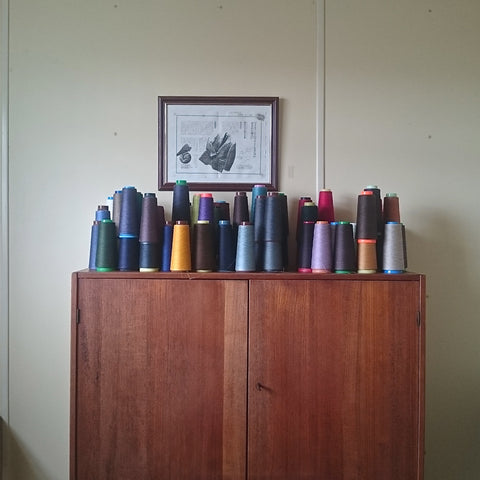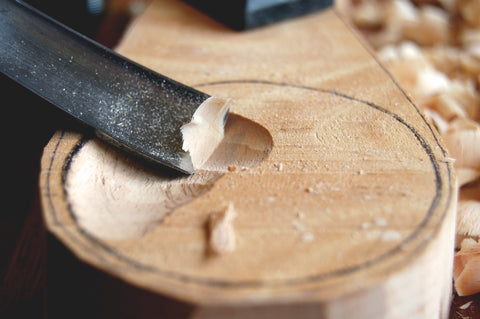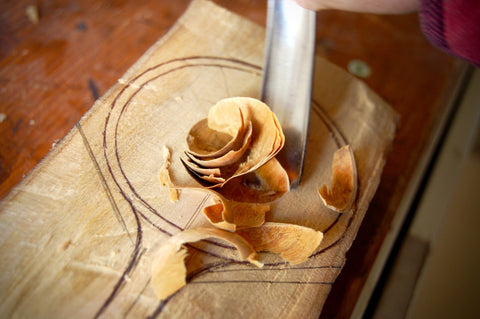
Maggie Marley - Letterpress Print
Posted by Clare Grennan in: botanical print, Donegal, fern print, greeting cards

What do you make?
I produce a range of stationery which includes letterpress greeting cards, prints and wedding invitations. I am presently developing a new product range which will include textiles.
Could you tell us a little bit about your studio?
I work from my garden studio in Donegal. It’s a log cabin that my hubby and myself built one weekend with the help of a carpenter. The studio is lovely and bright but it can get a bit chilly in the winter months.
Favourite thing about the space and how do you get into the mindset of making?
I love the wooden interior, it feels very Scandinavian which is a style I love. I surround myself with nice retro pieces of furniture and objects which inspire me to refine my design ideas. At the moment, because of my peaceful garden outlook, I have been focusing on botanical themes.
What is your favourite tool and why?
Afraid to say it, my favourite tool is my iMac but it's a love hate relationship. It’s great for scanning my drawings, creating artwork for printing plates, and testing colour combinations and patterns, but I hate having to spend long days on it.
Can you describe the making process and inspiration behind your work?
My typographical cards are inspired by vintage type and drawings, I try to keep them very crisp and clean. The botanical Letterpress range involves pressing plants, leaves and flowers in a book which are then scanned and traced to create black & white drawings for plate making. I then use a Vintage 1950’s Adana Letterpress machine to print the designs.
At the moment, I am in the process of developing new work inspired by the rural landscape and the Tory Island Painters. This involves more experimental mark making and repeat pattern designs. Eventually, everything is scanned to my computer so I can finalise designs for production.
What led you to choosing this craft as a profession?
When I undertook my foundation course in art college, I fell in love with printmaking, but I ended up studying Graphic Design. Fortunately though, we ended up doing loads of screenprint on the course. Many paths later (which included a stint studying furniture craftsmanship), I returned to hands-on printing with a final degree in Printed Textiles.
What do you love most about it?
I love the whole process from the experimental drawing and research to the mixing of inks/dyes and finally the physical printing, whether it be letterpress or screenprinting.
You can browse a selection of work from greeting cards to prints by Maggie in our Drury Street shop. Her collection of fern and ivy prints are available through our online shop here.

Emblem Weavers - Irish Linen
Posted by Clare Grennan in: Áras, Emblem weavers, family business, Homewares
Our search for a manufacturer of Irish linen led us to the sunny south east and Emblem weavers. With no finalised product in mind, we arranged to meet Stephen, who talked us through the various fabrics they produce, the weaving process and the history of this family business. Established in 1962 by Jim Conway (Stephen's father), Emblem Weavers grew from humble beginnings in a basement on Dublin's Amien Street. Having received money as a birthday gift from his mother, Jim bought two secondhand looms, made a yarn winder from a bicycle wheel, and wove his first lot of fabric samples. Initially selling door to door, Jim quickly gained a reputation for producing wonderful wool fabrics and began supplying large department stores and Dublin-based designers.
In 1981, Emblem Weavers invested in modern looms and began to weave colour woven Irish Linen. This was an immediate success following the presentation of the first collection at Interstoff (the international trade fair in Frankfurt.) and as a result, Emblem began supplying International fashion houses with their high-quality Irish fabrics. The growth of the business led Jim to expand Emblem Weavers and move location to Wexford.
Today, Emblem Weavers is very much a family affair with three of Jim’s nine children, Seamus, Stephen and Debbie directly engaged in the running of the business. They continue to produce the finest Irish linen and supply leading fashion designers Internationally. We hope to further develop our linen range with this family business in 2017.
You can shop our Emblem range here which includes our exclusive tea cloths and napkins.
For more information on the business and to view their current selection of linens, check out the Emblem website here.

Kathleen
Posted by Laura Caffrey in: Dublin stories, Geometric jewellery, granny, Irish design
In choosing to name our first collection of jewellery after the women in our families we were set the task of finding out more about these women's lives. I spent many Sunday afternoons last year questioning my parents about their childhoods, trying to tease out of them what they remembered about growing up, and the family stories they could recall.
Kay Halley (née Clarke) was born in Dublin in 1914. She was brought up in a Stoneybatter cottage by her oldest sister Nellie, as her mother passed away when she was just two years old. Her father worked as a cooper for Guinness', making the barrels and casks to store the stout in.
After working as a seamstress for a couple of tailors around Thomas Street and the South Circular Road, she married in 1939 and had four children. Living on a terraced road in Kilmainham, she was always enterprising, finding alternative ways to make a few bob. She organised a furniture club with the neighbours, a way to save up to buy a new sofa or kitchen table, as well as a coal club to budget for the cold months of winter, and used her sewing skills to run up curtains and clothes for anyone who needed them.
My clearest memory of my Nana Halley was spending an afternoon in her kitchen baking apple tarts (she made the the best apple tarts ever!) The radio was on in the kitchen, and Stevie Wonder was singing "I just called to say I love you" and we were singing along while we rolled out pastry. From then on that was our song. But the song I will always remember her by is "I'll take you home again Kathleen" which my Granda would regularly sing to her after a few pints of the black stuff.

Part of our inaugural Names collection, the Kathleen necklace is cut from a thick bar of round brass, then filed and sanded into shape by hand leaving contrasting matte and high polished finishes. It hangs on a long 32" ball chain and is available in either rose or yellow gold.

Tito The Spoon Maker
Posted by Anna Crudge in: Galway craft, handmade, Irish Design, permaculture

Florida born and Dublin reared Alberto Hogan is better known as Tito, or Tito The Spoon maker to give him his full title. Based in Galway for the last few years he’s spent his time there honing his craft. It was obviously time well spent, we've fallen in love with his beautifully crafted spoons and kitchen utensils and thought it time to share our love. We caught up with him to gain some insights into the life of a kitchen utensil maker.
What first sparked your interest in spoon making?
Around 2009 my wife introduced me to Permaculture design. It was from here that I started my journey into learning and understanding more about ecological design and traditional crafts. We both did a bushcraft course down in Kerry which involved a lot of knife skills, fashioning traps, shelters, tools etc. and it was there that I literally fell in love with the ability to make everything I need to live well in a forest with just a knife or a few simple hand tools using the wilderness around me as raw materials.
After this course, I continued carving. The shape of the spoon really allowed me to practice essential carving skills and also helped me understand the wood I was working with. As I was making my spoons I was posting them online, I saw that they got a lot of interest and one day I had a request to make 5 of them and it was this that sparked the idea of starting a small business.

Can you take us through your process?
First I go to the mills and lumber yards to look for wood, usually beech, cherry and walnut boards. I fill up my little jeep and then head home to plan out the next step.
I use cardboard templates to draw out the spoon shapes on the boards. Once I am satisfied with that I then go to Tuam where I use a friends shed space to cut the spoon shapes out. Ideally, a bandsaw is what would be used for this but since I have to be mobile I use a jigsaw to cut them out. Cutting takes about a day and I end up going home with a crate full of spoon blanks.
At home I can then scoop out the bowls and smooth then out using a sanding disc attached to a drill. Next I rough out the shape using my trusty axe.

Once the general shaping of the spoon is done I can then move on to the knife, carving and slicing the piece down to its final shape. Then I smooth out the rim of the bowl, evening out any rough surfaces and giving it that nice sharp transition from rim to inner bowl and then a more btle transition from rim to outer bowl where the knife marks are.A gentle pass of a polishing sponge really gives that silky smooth finish to the touch.
Using a pyrography pen I burn in the decorative lines. Burning into the cherry wood makes the smoke smell like cherry.
And finally a gentle pass of raw linseed oil makes the wood grain really highlight its beauty and creates a protective layer that slowly penetrates the wood, making it ready to use in the kitchen.

What do you find inspiring about your work?
One main thing that inspires me to do my work is that even if I have to make 10 or 20 of the same spoon, each one is going to be different.
Some can be a delight to make others can be very tricky but this makes the work exciting and refreshing every time. I love the idea that I am making something that is functional and long lasting, using a beautiful natural material that is regenerative and biodegradable and in my opinion, better looking with age.

What are the main challenges you face?
Right now, the major obstacle is not having a dedicated workspace where I can make my spoons and utensils in peace.
Being in an apartment I am quite limited with the axe since it makes quite a loud and continuous pounding sound. Generally during the day everyone is out working leaving me alone to chop away merrily but if it's an urgent job and I need to finish a lot of work then I head back out to my friends shed in Tuam and spend the day completing all of the axe work. For now, making my spoons in these conditions is fine but it does have its limits.

What does the future hold? do you plan to expand into other kitchen ware or stay true to being a spoon-maker?
I applied for this space in the Spiddal Craft Village so if that works out I can then be producing at 100%. Having a dedicated space means I can explore and develop so much more and yes, I definitely want to expand into different areas producing bowls, cups, boards and more unique one-off pieces but I also want to produce tools as well. I have been throwing some ideas around with some local blacksmiths about collaborating in making handmade tools for carpentry and forestry, things like chisels, knives, axes, drawknives, froes and adzes.
Like wooden spoons, these tools never get outdated and in reality many of the hand tools produced back when it was just wood, steel and leather are as quick and effective as any of their power-tool counterparts that are overly complex and require electricity.
Spoons, I think I will always make, and this title of spoon-maker will be a reminder to me of where it all began.
Tito's spoons are a great addition to any kitchen and look great paired with Dunbeacon pottery.

A starry eyed Alex
Posted by Laura Caffrey in: 2016 Calendar, Alex Synge, Astrology, Christmas gift

Three years ago we had a chat with our good friend Alex Synge about the idea of producing an annual wall calendar for Irish Design Shop. After a bit of playing around with what we might do we shelved the idea until last year when we produced our first calendar with The Project Twins. This 2015 calendar was so popular, that we decided to make it an annual project, and enlist the talents of a leading Irish designer, illustrator or artist to come up with the artwork and theme.
So finally, this January we sat down with Alex again and started to plan a calendar for 2016, and we think it has been worth the wait. The concept behind this Calendar of Constellations was all Alex's idea. His amateur interest in the night sky has turned into a project which reaches far beyond any of our expectations.
The calendar comprises 13 beautiful lithographic prints of the constellations. Printed one colour, silver ink on black stock, each month includes informative descriptions of what might be on view in the night skies above Ireland at that time. These 300mm square prints are perforated to be kept long after the month has passed. We have enlisted our framer Conor to create a bespoke limed ash frame to fit the perforated images perfectly. Also, a limited edition tote bag has been produced which will be available to purchase along with the calendar and handmade frames from Thursday November 5th.



